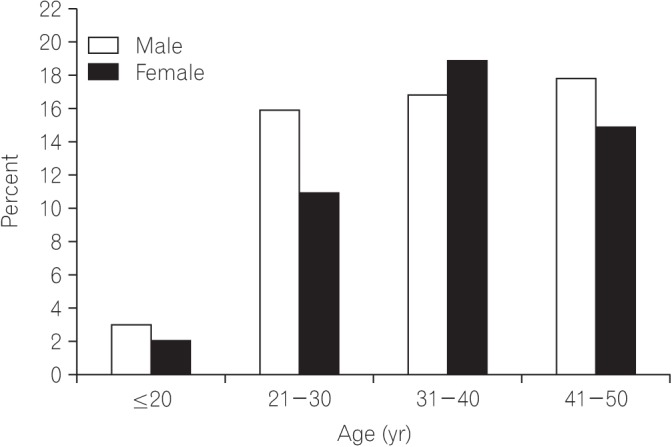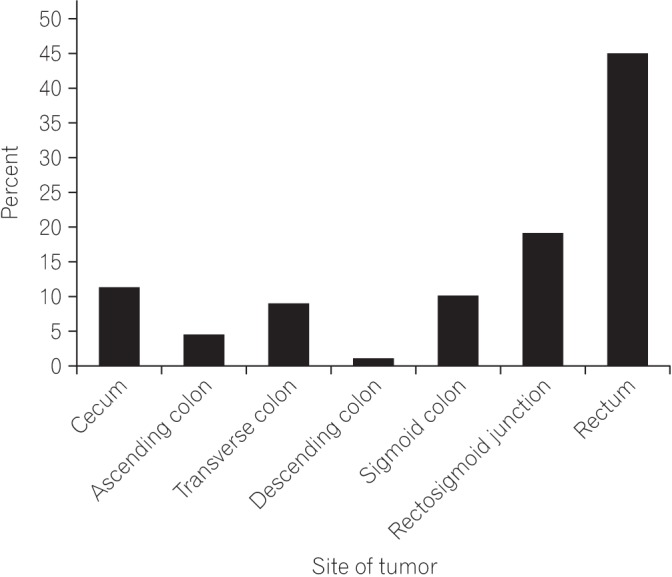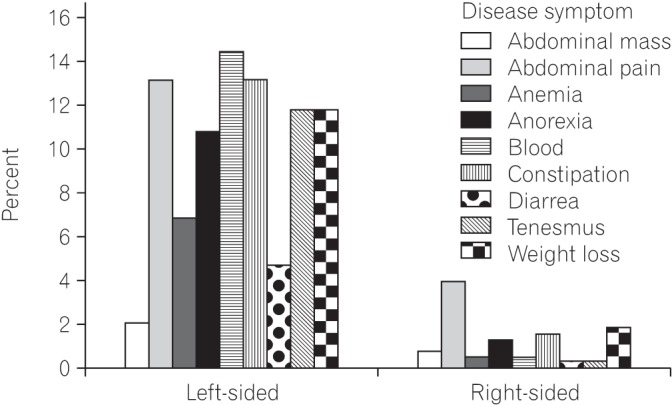Intest Res.
2017 Apr;15(2):203-207. 10.5217/ir.2017.15.2.203.
Red flag symptoms: detailed account of clinicopathological features in young-onset colorectal cancer
- Affiliations
-
- 1Department of Environmental Sciences (Biotechnology), Fatima Jinnah Women University, Rawalpindi, Pakistan. ramish_exclusive@hotmail.com
- KMID: 2425162
- DOI: http://doi.org/10.5217/ir.2017.15.2.203
Abstract
- BACKGROUND/AIMS
Colorectal cancer has long been considered disease of the West, typically occurring in old age; however, the incidence is rising in Asia. The pattern of disease is quite different in Asia, occurring at a younger age and at an advanced stage. Recognition of disease at an early stage is still a challenge for physicians. Few data are available regarding young-onset colorectal cancer in Pakistan. We conducted this study to fill this gap and provide deeper insight into clinical symptoms and histopathological features of young-onset colorectal cancer.
METHODS
We collected data regarding clinical features by directly interviewing patients and obtaining histopathological data from hospital records. Patients aged less than 50 years were included in the study. Statistical analysis was performed using IBM SPSS version 20.0.
RESULTS
Results in 105 patients showed mean age at diagnosis was 35.90±9.39, with male predominance; the majority of patients had no family history of colorectal cancer. Most patients had left-sided tumors with advance stage and intermediate grade (grade 2). Mucinous histology was common. Rectal bleeding was the first symptom for left-sided tumors, whereas most of the right-sided lesions presented with sudden obstruction.
CONCLUSIONS
Painless rectal bleeding in the early thirties should alert physicians to advise appropriate investigation, as the majority of young-onset colorectal cancer patients develop painless bleeding 2 to 3 years before appearance of other symptoms.
MeSH Terms
Figure
Cited by 1 articles
-
Is colorectal cancer screening necessary before 50 years of age?
Yoon Suk Jung
Intest Res. 2017;15(4):550-551. doi: 10.5217/ir.2017.15.4.550.
Reference
-
1. Center MM, Jemal A, Smith RA, Ward E. Worldwide variations in colorectal cancer. CA Cancer J Clin. 2009; 59:366–378. PMID: 19897840.
Article2. Pourhoseingholi MA. Epidemiology and burden of colorectal cancer in Asia-Pacific region: what shall we do now? Transl Gastrointest Cancer. 2014; 3:169–173.3. Punjab Cancer Registry. Punjab cancer registry report-4. Lahore: Punjab Cancer Registry;2016.4. Ballester V, Rashtak S, Boardman L. Clinical and molecular features of young-onset colorectal cancer. World J Gastroenterol. 2016; 22:1736–1744. PMID: 26855533.
Article5. Deen KI, Silva H, Deen R, Chandrasinghe PC. Colorectal cancer in the young, many questions, few answers. World J Gastrointest Oncol. 2016; 8:481–488. PMID: 27326317.
Article6. Ahmed A, Afzal A, Asif HM, et al. Changing trends of presentation in colorectal carcinoma. Pak J Med Sci. 2014; 8:233–237.7. Hadi NI, Kafil N, Waseem B, Alamgir M. Incidence of colorectal carcinoma: is there a “shift to the right”? Pak J Pharmacol. 2009; 26:1–5.8. Rosato V, Bosetti C, Levi F, et al. Risk factors for young-onset colorectal cancer. Cancer Causes Control. 2013; 24:335–341. PMID: 23224326.
Article9. Wilson JA. Colon cancer screening in the elderly: when do we stop? Trans Am Clin Climatol Assoc. 2010; 121:94–103. PMID: 20697552.10. Jess P, Hansen IO, Gamborg M, Jess T. Danish Colorectal Cancer Group. A nationwide Danish cohort study challenging the categorisation into right-sided and left-sided colon cancer. BMJ Open. 2013; 3:e002608. DOI: 10.1136/bmjopen-2013-002608.
Article11. Baichoo E, Boardman LA. Genetics of young onset colorectal cancer. Hereditary Genet. 2013; 3:124.
Article12. Dozois EJ, Boardman LA, Suwanthanma W, et al. Young-onset colorectal cancer in patients with no known genetic predisposition: can we increase early recognition and improve outcome? Medicine (Baltimore). 2008; 87:259–263. PMID: 18794708.
Article13. Nitsche U, Zimmermann A, Späth C, et al. Mucinous and signetring cell colorectal cancers differ from classical adenocarcinomas in tumor biology and prognosis. Ann Surg. 2013; 258:775–782. PMID: 23989057.
Article14. Benedix F, Kuester D, Meyer F, Lippert H. Influence of mucinous and signet-ring cell differentiation on epidemiological, histological, molecular biological features, and outcome in patients with colorectal carcinoma. Zentralbl Chir. 2013; 138:427–433. PMID: 22274919.
Article15. McPhail S, Johnson S, Greenberg D, Peake M, Rous B. Stage at diagnosis and early mortality from cancer in England. Br J Cancer. 2015; 112(Suppl 1):S108–S115. PMID: 25734389.
Article16. Ahnen DJ, Wade SW, Jones WF, et al. The increasing incidence of young-onset colorectal cancer: a call to action. Mayo Clin Proc. 2014; 89:216–224. PMID: 24393412.
Article17. Amini AQ, Samo KA, Memon AS. Colorectal cancer in younger population: our experience. J Pak Med Assoc. 2013; 63:1275–1277. PMID: 24392559.18. Barresi V, Reggiani Bonetti L, Ieni A, Caruso RA, Tuccari G. Histological grading in colorectal cancer: new insights and perspectives. Histol Histopathol. 2015; 30:1059–1067. PMID: 26004398.
- Full Text Links
- Actions
-
Cited
- CITED
-
- Close
- Share
- Similar articles
-
- Strategies for colorectal cancer screening and post-polypectomy surveillance for young adults under age 50
- Comparison of Colonoscopy Surveillance Outcomes Between Young and Older Colorectal Cancer Patients
- Early-onset Colorectal Cancer
- Clinical Analysis and Red Flag Signs in Pediatric Headache According to Age
- Prognostic and clinicopathological significance of Fusobacterium nucleatum in colorectal cancer: a systemic review and meta-analysis




